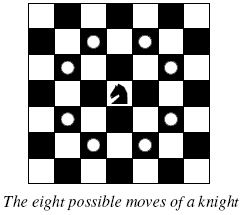|
A Knight's Journey
Description  Background
Background
The knight is getting bored of seeing the same black and white squares again and again and has decided to make a journey around the world. Whenever a knight moves, it is two squares in one direction and one square perpendicular to this. The world of a knight is the chessboard he is living on. Our knight lives on a chessboard that has a smaller area than a regular 8 * 8 board, but it is still rectangular. Can you help this adventurous knight to make travel plans? Problem Find a path such that the knight visits every square once. The knight can start and end on any square of the board. Input
The input begins with a positive integer n in the first line. The following lines contain n test cases. Each test case consists of a single line with two positive integers p and q, such that 1 <= p * q <= 26. This represents a p * q chessboard, where p describes how many different square numbers 1, . . . , p exist, q describes how many different square letters exist. These are the first q letters of the Latin alphabet: A, . . .
Output
The output for every scenario begins with a line containing "Scenario #i:", where i is the number of the scenario starting at 1. Then print a single line containing the lexicographically first path that visits all squares of the chessboard with knight moves followed by an empty line. The path should be given on a single line by concatenating the names of the visited squares. Each square name consists of a capital letter followed by a number.
If no such path exist, you should output impossible on a single line. Sample Input 3 1 1 2 3 4 3 Sample Output Scenario #1: A1 Scenario #2: impossible Scenario #3: A1B3C1A2B4C2A3B1C3A4B2C4 Source
TUD Programming Contest 2005, Darmstadt, Germany
|
题目大意:
有T组测试数据,每组有 p 和 q 两个数,表示棋盘大小,p 行 q 列,棋子能否不重复的走完棋盘中所有的格子,是则按照字典序输出路径,否则输出 impossible;
思路:
就是一道规规矩矩的深搜 的题目,按照字典序遍历,所以周围八个可走格子的遍历顺序为:
#include <iostream>
#include <cstdio>
#include <cstdlib>
#include <cstring>
using namespace std;
int dir[8][2] = {{-1,-2},{1,-2},{-2,-1},{2,-1},{-2,1},{2,1},{-1,2},{1,2}}; //方向数组
int vis[30][30]; //标记是否走过
int mp[30][2]; //记录路径
int p, q;
int flag; //标记是否走完
bool out(int x, int y) //判断是否越界
{
if( x>=0&&x<p&&y>=0&&y<q )
return true;
return false;
}
void dfs(int x, int y, int deep)
{
mp[deep][0] = x;
mp[deep][1] = y;
if( deep==p*q ) //遍历完了flag改变,跳出
{
flag = 1;
return;
}
for( int i = 0;i < 8;i++ )
{
int xx = x + dir[i][0];
int yy = y + dir[i][1];
if( !out(xx,yy) ) continue; //若越界,继续下一步
if( !flag &&!vis[xx][yy] )
{
vis[xx][yy] = 1;
dfs(xx,yy,deep+1);
vis[xx][yy] = 0;
}
}
}
int main()
{
int T;
cin>>T;
for( int test = 1;test <= T; test++ )
{
cin>>p>>q;
memset(vis,0,sizeof(vis));
flag = 0;
vis[0][0] = 1;
dfs(0,0,1);
printf("Scenario #%d:\n",test);
if( flag )
{
for( int i = 1;i <= p*q;i++ )
{
printf("%c%d",mp[i][1]+'A',mp[i][0]+1);
}
cout<<endl;
}
else
cout<<"impossible"<<endl;
cout<<endl;
}
return 0;
}











 本文探讨了一个经典的计算机科学问题——骑士周游问题。该问题要求在一个缩小版的国际象棋棋盘上找到一条路径,使得骑士能够恰好访问每个方格一次,并提供了一种使用深度优先搜索算法来解决这一问题的方法。
本文探讨了一个经典的计算机科学问题——骑士周游问题。该问题要求在一个缩小版的国际象棋棋盘上找到一条路径,使得骑士能够恰好访问每个方格一次,并提供了一种使用深度优先搜索算法来解决这一问题的方法。

















 865
865

 被折叠的 条评论
为什么被折叠?
被折叠的 条评论
为什么被折叠?








